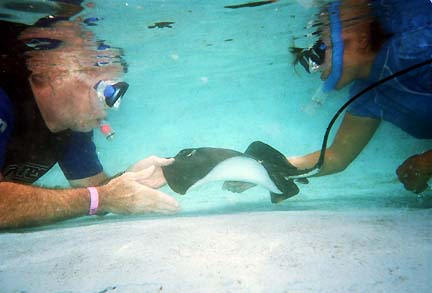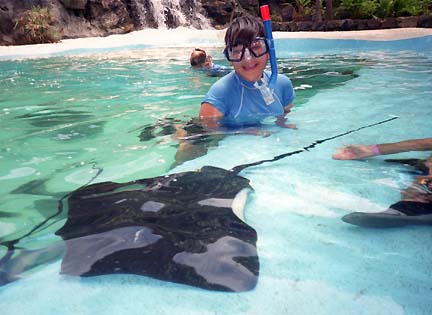Advertisement - Click to support our sponsors.


SITTING on a concrete bench in some 18 inches of saltwater, my body is backed against the side of the manmade lagoon as a stingray slides across my most tender region.
Reporter Tim Ryan dives
into the new Stingray Encounter
program at Sea Life ParkBy Tim Ryan
Star-Bulletin"Oh God," I mutter to myself, wondering if this juvenile Pacific Brown stingray's tiny, plated mouth -- hidden somewhere on its underside -- is searching for a morsel to munch.
"He's just curious; it's OK," said Sea Life Park "facilitator" LeeAnn Morikami, who's holding several bite-sized chunks of fish for the 14 rays in the park's newest interactive exhibit.
She's right. When Morikami slips the fishy treat within reach of the stingray's mouth, this gentle, curious creature -- with a sudden whooshing sound -- sucks the chunk up like a mini vacuum cleaner before crushing it between its plates.
I start to breathe again and let my hand sink onto the stingray's back. As gracefully as he glided to me, the creature slides into deeper water.
The Stingray Encounter allows park visitors -- at least 40 inches tall -- the opportunity to swim face to face -- or groin to bony plates -- with the odd, triangular fish.
UP CLOSE
What: The Stingray Encounter
Where: Sea Life Park
When: Sessions for maximum of six people run every 40 minutes from 9:30 a.m to 4:30 p.m. daily
Cost: $49 per person includes park admission
Call: 259-7933
All the rays in this exhibit are juveniles, with a wingspan no wider than 3 feet, with 3-foot tails. The really big ones with 6-foot wing spans are in the 300,000-gallon Hawaiian Reef Tank. Encounter visitors might be advised that what you see underwater tends to look a lot larger than from above.
Stingrays are closely related to sharks, with both having a skeleton made of cartilage instead of bone. Rays usually feed on animals found on the ocean floor, such as crabs, shrimp and mollusks.
One reason Sea Life Park created its encounter programs -- they have three others with dolphins and in the reef tank -- is to spark environmental awareness and conservation, said George "Paka" Nishimura, the park's curator.
"Surveys have shown that people who have an encounter with animals and fish like the ones Sea Life Park provide take home the message that conserving all creatures large and small is everyone's responsibility," he said.
Stingray Encounter participants first are told the rules, such as no chasing or grabbing the fish. A wetsuit, snorkel, mask and fins are provided. Life vests are also mandatory, not so much to keep people from drowning but to prevent "over-enthusiastic" visitors from diving deep to chase the rays, Morikami said.
You're also shown an area of the lagoon where the rays can retreat without being followed by "guests." Make no mistake: Breaking the rules once is tolerated with a warning. The second time, it's outta the pool.

With just me in the lagoon this day, the rays are curious and hungry. They approach like underwater gliders, silent, moving effortlessly, tiny black eyes distinctly focusing on this stranger.The tops of their bodies are dark; the undersides are almost white; tails are dark gray to black. The easily distinguishable stinger is at the base but these are clipped to protect the careless from getting stung.
Initiating encounters with visitors is easy: facilitators like Morikami -- one for a group of six -- lure rays to visitors with the promise of food. The rays know the routine. I sat still and nervous while a half-dozen rays brushed over my thighs to get at Morikami's fishy treats.
Never did these little rays act aggressive. If they felt threatened, they swam away. In 10 minutes, the rays became accustomed to having me in their home. Several swam around, up and over me, brushing my body with silky fins and including me in their underwater ballet. Even with my snorkel poking above the water's surface, I had to remind myself to breathe; the experience was mesmerizing.
Feeding rays doesn't come too easy to the uninitiated. The first instinct as they glide over your hand is to let go of the fish chunk expecting them to nab it.
"Try it this way," Morikami said, grabbing my hand.

As one of the largest rays in the lagoon approached -- I nicknamed it B-52 -- Morikami turned my hand toward the surface with the fish between my fingers wiggling in the current.Morikami's grip was firm. The ray slowed; the tip of its noise twitched; the body lowered a bit as the mouth approached the food. And my fingers.
I closed my eyes, planning a Worker's Comp claim.
Suddenly, a vacuum of water started flowing over my fingers. Morikami felt it too. She released my fingers and the fish disappeared into the ray's mouth.
"You did it," she said, smiling.
"I did," I repeated. "Wow!"
Now I head out on my own, fish food in hand, shaking it to attract another ray. One of the smaller rays keeps getting closer and closer, eventually meeting me nose to nose. It remained still for several seconds, staring, while I touch the remarkably soft tissue of its fin. It takes the fish I am holding then turns to leave, its tail brushing my cheek.
Though I spend just 40 minutes in the lagoon I'm exhilarated and tired. On the drive home I revisit in my memory the gentleness of the rays eating from my hand, the seeming fragility of their skin, but most of all the most basic communication between two living creatures normally occupying two different worlds.
Click for online
calendars and events.